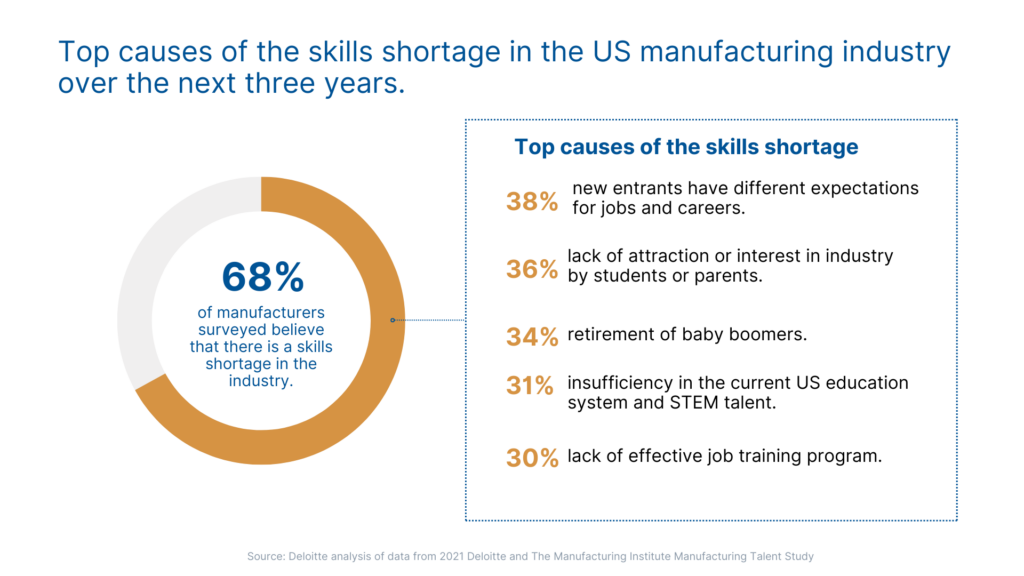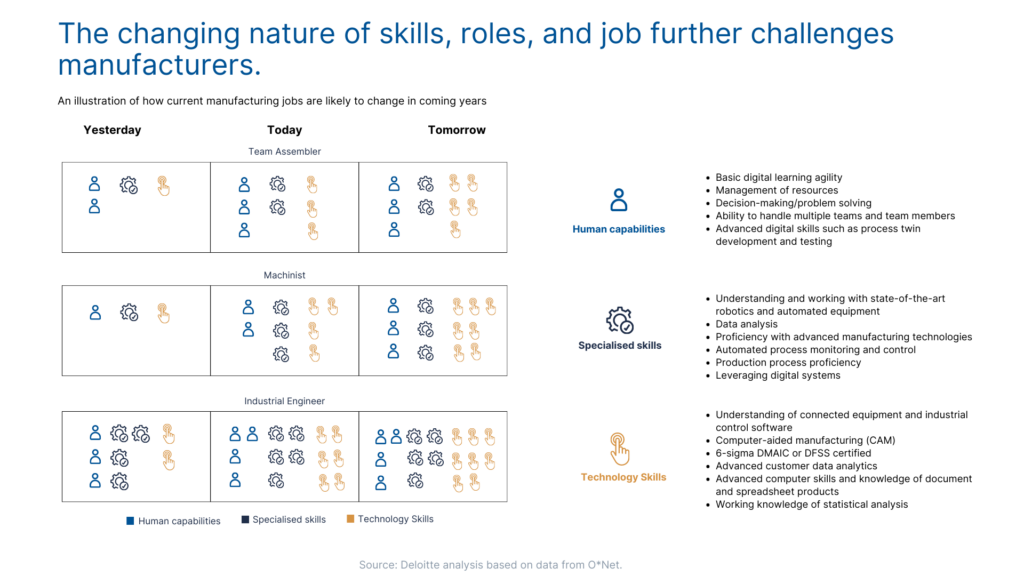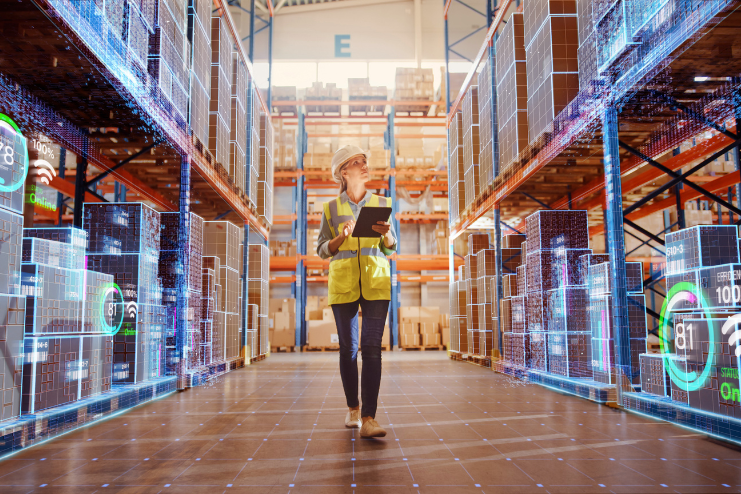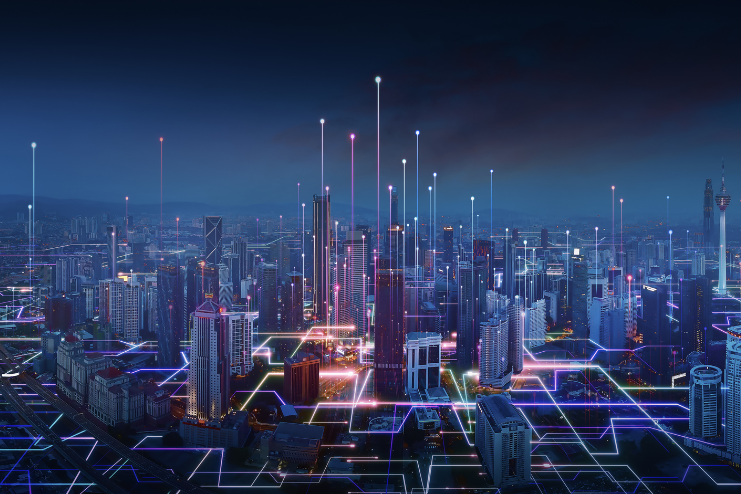A healthy manufacturing industry is crucial for ensuring the sustainable long-term well-being of a country and its citizens. Manufacturing jobs are essential for economic growth, innovation, global competitiveness, skills development, and career opportunities.
Yet, despite the many benefits a robust manufacturing industry can bring, business owners struggle to attract new talent due to the mismatch between the skills employers need and job seekers’ skills — the skills gap.
The skills gap in the manufacturing industry is a significant concern for many business owners. The shortage of skilled workers has been a challenge in the industry for years, and it’s only worsening. However, with the help of artificial intelligence (AI), manufacturers can attract new talent and address the skills gap.
In this article, we’ll explore how AI is helping to address the skills gap in the manufacturing industry. We’ll cover:
-
What’s causing the skills gap
-
Assess the impact of AI
-
Examples of how AI is helping
-
How employers can leverage AI today
The skill gap in manufacturing
The manufacturing industry is facing a massive skills gap. According to a report by Deloitte and the Manufacturing Institute, where 800 US manufacturers were interviewed, US manufacturing alone is expected to have 2.1 million unfilled jobs by 2030.
This gap is due to several factors, including the retirement of baby boomers, lack of interest among younger generations, and the increasing complexity of manufacturing technology.

The study also revealed a silver lining. It found that the pace of digital manufacturing transformation will continue redefining work for humans. Our key takeaway is redefining work, which we believe is good.
At Aicadium, we believe that humans will always be a necessary part of the manufacturing equation, and the study also agrees. Even though 2.7 million industrial robots are currently in use, such as fixed robotic arms, moving cobots, and autonomous-guided vehicles moving materials and finished goods, humans are still needed to help produce the vast majority of goods the industry makes worldwide.
Humans are needed for many reasons. Here are two that the Deloitte report mentioned:
-
humans can follow instructions,
-
and the willingness to learn.
Today’s technological advancements serve as a complement to human workers rather than a replacement. Though this symbiotic relationship is good, it does require workers to develop different skills, which can further worsen the skills gap as older workers get ready to retire and don’t have the desire to learn. Potential new workers are either uninterested or don’t know enough to engage with employers.
The complexity of new technology is causing significant problems for manufacturers. Companies struggle to find workers with the necessary skills to operate and maintain their equipment. This leads to increased downtime, lower productivity, and higher costs. Moreover, the lack of skilled workers hamper the industry’s ability to grow and compete in the global market. So, while we see the positive impacts of AI in manufacturing, we find ourselves in a state of transition amid the AI revolution.
AI’s impact on work
I’ll start by stating that ChatGPT and Jasper.AI assisted me in writing this article. ChatGPT assisted me in finding relevant, reputable articles to support my topic, while Jasper.AI served as an extra set of eyes that helped me improve sentence structures. And while a combination of these tools could have easily written this article, it still needed a human to lead it because there would be no topic, context, or comprehensive flow without a human in the mix.
If your only worry is to write an average article without fact-checking, the thought of AI tools can be intimidating. However, accepting and familiarising yourself with them can enhance your writing and provide valuable lessons. The same ideas apply to AI manufacturing.
Today, unfilled manufacturing jobs are split between entry and middle-skill levels.
-
Entry-level jobs don’t require technical know-how or industry knowledge,high school graduates can fill these jobs, and starting wages are typically higher than the minimum federal wage in the U.S.
-
Middle-skill jobs require technical and specialised skills that need several months to more than a year of hands-on training or licensing and certification.
Many manufacturers are facing pressure from both types of job shortages. However, the industry faces an even greater challenge — digital transformation. As digital transformation in the manufacturing industry continues to develop and evolve, so will the skills needed to do the jobs. The illustration below shows how manufacturing skills, roles, and jobs will likely change in the coming years.

As the illustration shows, workers will need to evolve, but that cannot happen without a commitment from employers to upskill workers quickly to learn new technology. Employers need to care as much about upskilling workers as they do about digital transformation to succeed.
Manufacturers that have not adequately planned for the changes in the workforce may face difficulties when trying to adjust. According to the 2020 Deloitte Global Human Capital Trends Study, 75% of industrial organisations considered reskilling their workforce as important or very important for their success in the upcoming year. However, only 10% of these organisations are prepared to tackle this trend.
Examples of how AI is helping
Research done by Yong Suk Lee, an assistant professor at the University of Notre Dame’s Keough School of Global Affairs, found that advanced digitisation and automation in certain industries, such as the automotive industry, filled gaps that were left vacant by employees while creating new tasks that required the hiring of more employees.
In his study, he examined the influence of robots on the U.S. labour market between 2005 – 2016, analysing the data in five-year intervals. For the first five years, robots had a negative impact on the number of human employees, but the impact rebounded and turned positive. Tracking the reversal to determine the sources led to three factors:
-
automation of tasks and a reduction in production costs
-
improvements in robot technology performing the same tasks
-
creation of new tasks spurred by those automation technologies and abilities
Lee explains that “When robots were initially introduced, the intent was to cut costs and replace human workers. But now companies are using ‘collaborative robots’ or ‘cobots,’ which are designed to work together with humans,” a trend that many companies are adopting.
Cobots work with humans
Cobots use a combination of sensors, cameras, and algorithms to detect and respond to human presence, movements, and behaviour. This enables them to operate safely and smoothly alongside humans without risk of injury or harm.
Some of the key features that enable cobots to work collaboratively with humans include:
-
Force sensing: Cobots can sense how much force they apply to objects and adjust their movements accordingly, allowing them to perform tasks that require a gentle touch or delicate precision.
-
Vision systems: Cobots can “see” their surroundings using cameras and other sensors. This enables them to detect the presence of humans and other objects in their workspace and adjust their movements accordingly.
-
Programming: Cobots can be programmed to perform various tasks and movements. Depending on the task, they can also be programmed to operate at different speeds and force levels.
Overall, cobots are designed to work collaboratively with humans rather than replace them. They are well-suited for tasks that require precision, consistency, and repeatability and can help improve productivity and efficiency.
How employers can leverage AI today
AI has the potential to fill the skills gap in the manufacturing industry. Here are some ways that AI is helping to address this issue:
Training and upskilling
AI can be used to train and upskill workers. Machine learning algorithms can analyse workers’ performance and provide feedback on areas they need to improve. This feedback can be used to develop personalised training programs for each worker. AI can also simulate different scenarios and provide workers with a safe environment to learn new skills. This type of training can be done remotely, which allows workers to learn at their own pace and on their own schedule.
Autonomous systems
Autonomous systems can help to address the skills gap by reducing the need for human intervention. For example, self-driving vehicles can transport materials and products throughout a factory without a human driver. This frees workers to focus on more complex tasks requiring human skills. Autonomous systems can also perform dangerous or difficult tasks for humans, such as working in hazardous environments or lifting heavy objects.
Predictive Maintenance
AI can be used to monitor equipment and predict when maintenance is needed. This helps to reduce downtime and increase productivity. Predictive maintenance can also help extend the equipment’s life, reducing the need for expensive replacements. This type of maintenance can be done using sensors placed on the equipment. The sensors monitor the equipment and send data to an AI system that analyses the data and provides recommendations for maintenance.
Recruitment
AI can help manufacturers attract new talent by identifying candidates with the skills they need. Machine learning algorithms can analyse resumes and job descriptions to identify candidates with the necessary qualifications. This can save time and money by reducing the need for manual screening. AI can also create personalised job postings that target specific candidates based on their skills and experience.
Conclusion
The skills gap in the manufacturing industry is a major challenge that needs to be addressed. AI has the potential to help manufacturers attract new talent and address the skills gap. Manufacturers can improve productivity, reduce downtime, and compete globally by using AI for training and upskilling, autonomous systems, predictive maintenance, and recruitment. As AI technology continues to evolve, we can expect to see even more solutions helping close the skills gap and opening new opportunities in the manufacturing industry.
At Aicadium, we work closely with organisations to implement computer vision AI in a variety of ways. We help companies leverage their camera infrastructure to assist workers with visual inspection while keeping them safe and productive. If you’re interested in learning more about how we can help your organisation, schedule a 15 min call today.





